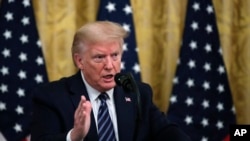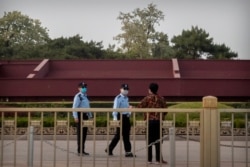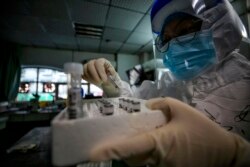U.S. President Donald Trump says he has a “high degree of confidence” the coronavirus pandemic originated in a Chinese laboratory, going beyond a rare, public assessment issued hours earlier by his top intelligence agency.
Asked late Thursday if he has seen evidence from U.S. intelligence officials that COVID-19 came from the Wuhan Institute of Virology, the president replied, “Yes, yes I have,” though he declined to share any details.
“I’m not allowed to tell you that,” he added.
While most scientists agree the coronavirus pandemic originated in Wuhan, China, there has been endless speculation about how the virus jumped from animals to humans, with many conspiracy theorists clinging to the theory that COVID-19 was engineered on purpose.
U.S. intelligence officials earlier Thursday, however, said they have ruled out that scenario.
The U.S. intelligence community “concurs with the wide scientific consensus that the COVID-19 virus was not man-made or genetically modified,” the Office of the Director of National Intelligence said.
Nonetheless, the statement left open the possibility the outbreak could still have ties to Chinese researchers.
“The IC [intelligence community] will continue to rigorously examine emerging information and intelligence to determine whether the outbreak began through contact with infected animals or if it was the result of an accident at a laboratory in Wuhan,” it said.
The Chinese government-backed Wuhan Institute of Virology has denied allegations it was the source of the initial COVID-19 outbreak, and many experts have said the virus most likely made the jump from animals to people in a nearby wildlife market.
Trump, though, has repeatedly cast doubt on China’s denials, accusing both Beijing and the World Health Organization of misleading the rest of the world on how and when the pandemic started.
“There’s a lot of theories,” Trump said Thursday, adding Chinese officials need to stop withholding key details.
“So far, I think China is trying to be somewhat transparent with us,” he added.
Other top U.S. officials, like Secretary of State Mike Pompeo, also have questioned China’s willingness to come forward with key information.
But during an interview with a local radio station in Iowa, Pompeo declined to go as far as the president in his assessment of the virus’s origins.
“We don’t know if it came from the Wuhan Institute of Virology. We don’t know if it emanated from the wet market or yet some other place,” he said. “We don’t know those answers.”
Yet whether any conclusive evidence has emerged, Thursday’s statement from the Office of the Director of National Intelligence would appear to indicate U.S. intelligence officials have at least come to a better understanding.
Two weeks ago, a U.S. intelligence official told VOA that while agencies were “actively and vigorously tracking down every piece of information,” the community had “not collectively agreed on any one theory.”
Some former U.S. intelligence officials, though, are viewing Thursday’s statement with a degree of suspicion, pointing to what they see as the president’s ongoing efforts to politicize the U.S. intelligence apparatus.
“It certainly is unusual, and reflects the politically charged nature of the topic as the Trump administration tries hard to deflect attention from its own performance during the pandemic,” said Paul Pillar, a former senior CIA officer who has been critical of the administration.
“The statement appears to be a compromise that makes the IC [intelligence community] appear to be working objectively without pouring cold water on the White House's favorite rhetorical line about Chinese malfeasance,” said Pillar, now with Georgetown University.
Others, however, see the statement as a smart move, given the onslaught of disinformation that has surrounded the pandemic.
“[It’s] doubtful that this was spin or U.S. disinformation,” said Larry Pfeiffer, a former CIA chief of staff and former senior director of the White House Situation Room, who like Pillar has been critical of the White House’s handling of intelligence matters. “I give the ODNI credit for stepping up to the plate to add some clarity to the situation.”
The statement may also portend a greater public role for U.S. intelligence agencies going forward.
“These are trying times,” said Daniel Hoffman, a retired senior CIA officer. “There’s a lot of disinformation, misinformation and ignorance.”
That informational fog, according to Hoffman, has only compounded by China’s refusal to quickly and transparently come forward with all of the information it has on the origins of the virus.
“We’re relying on out intelligence community to fill in the gaps in what we know,” he said.







